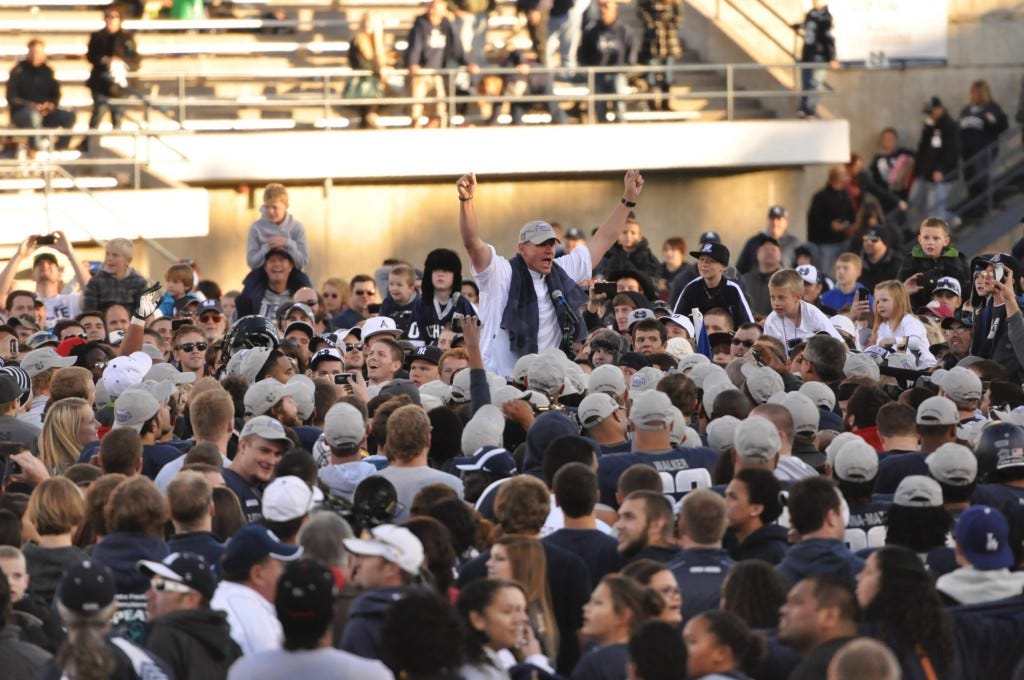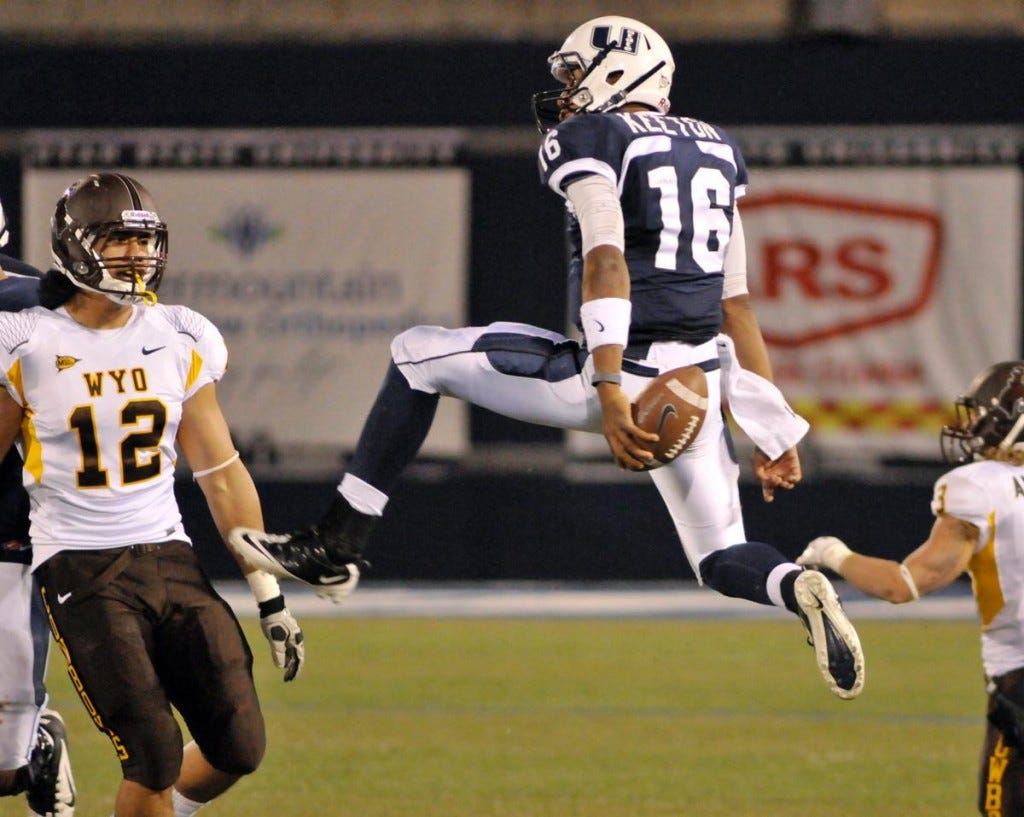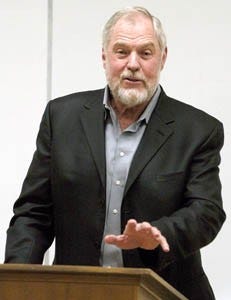The Top Six Legends Of Utah State Football: Part One
Coaches, Offensive Players, and Defensive Players
Originally published at The Utah Statesman on October 13, 2021.
This article is part one of a two part series. Catch up with Part Two: Wins, Losses, and Seasons.
Also check out:
The Top Six Legends Of Utah State Football: Part Two
The Complex Legacy of Gary Andersen
The Top Six Legends Of Utah State Football: Part One
The Top Six Legends Of Utah State Football: Part One
Offensive Players, Defensive Players, and Coaches
As featured in the 2021 Football Preview Magazine.
Editor note: Utah State boasts a long history of football success. Parker Ballantyne takes a deep dive into the top six coaches, offensive players and defensive players throughout the program’s history.
Honorable Mentions
Cornell Green; Defensive Players
1960-1962
Green didn’t play football at Utah State but had 13-year NFL career as a defensive back for the Dallas Cowboys after leading the basketball team for three years.
Kent Ryan; Offensive Players
1934-1937; Running back
1936 All-American.
Savon Scarver; Offensive Players
2017-current; Wide receiver
2018 Consensus All-American.
Charlie Weatherbie; Coaches
1992-1994; 15-19 (11-7)
Led Utah State to a conference championship and first-ever bowl victory in 1993.
Coaches
Number 6: Bruce Snyder
1976-1982; 38-37-2
Bruce Snyder coached the Aggies for two seasons as an independent team, and then in the Pacific Coast Athletic Association. Their first four seasons in the conference, the Aggies were co-champions, champions, second and second.
Number 5: Clayton Teetzel
1909-1915; 24-18-2
As one of the first Utah State coaches, Clayton Teetzel oversaw some of the early success of the program. Teetzel was the coach of Utah State’s perfect season in 1911 when the Aggies outscored opponents 164-0. He also went 2-1 against one of Utah State’s oldest rivals, the Wyoming Cowboys.
Number 4: Matt Wells
2013-2018; 44-34
Matt Wells coached the Aggies from 2013-2018 and was a two-time Mountain West coach of the year (2013, 2018). Coach Wells has more bowl appearances than any other head coach in Utah State history with four. It would have been five, but he left for Texas Tech before the New Mexico Bowl in 2018. Under coach Wells, the Aggies finished outside of the top four of the Mountain West only once.
Number 3: John Ralston
1959-1962; 31-11-1
Three of John Ralston’s four seasons were spent in the Skyline Conference. In those three years, the Aggies won two conference championships and went to two bowl games before going independent. In 1961, the Aggies went 9-1-1 and finished the season ranked No. 10 in the nation.
Number 2: Gary Andersen
2009-2012, 2019-2020; 33-33
The man who built Maverik Stadium. Gary Andersen took over a decrepit program that had gone a combined 3-21 in the previous two seasons. The immediate improvements were not drastic as the Aggies won three, four and five games in his first three seasons respectively. Then, in 2011, Andersen’s Aggies turned the corner and went 7-6 — reaching their first bowl game 14 years. The next year Andersen would lead the team to a Western Athletic Conference championship and the Aggies first bowl win in 19 years. Andersen went 26-24 in his first tenure at Utah State and although his return in 2019 was not as successful, Gary Andersen is one of the most important and successful coaches in Aggie history.
Number 1: E.L. “Dick” Romney
1919-1942, 1944-1948; 128–91-16
Ernest Lowell “Dick” Romney coached at Utah State for 29 seasons. He is one of the most recognizable and important figures in all of Utah State Athletics history. He was not only a football coach for 29 years but was also the head coach for basketball, baseball, and track as well as the athletic director for 31 years. He brought the Aggies their first-ever conference championship, and led Utah state to four conference titles and five second-place finishes. He also went 224-158 as the basketball coach. In 1927, Utah State’s football stadium was named after him. It would remain that way until 2015 when it was renamed Maverik Stadium. Romney is also a Hall of Fame inductee at Utah State and the National Football Foundation.
Offensive Players
Number 6: Chris Cooley
2000-2003; Tight End
Hailing from Logan, Utah, Chris Cooley was inducted as a member of the USU athletics hall of fame in 2017. According to Utah State, Chris Cooley is “Regarded as the best tight end in Utah State football history.” As a senior, Cooley led all tight ends in the nation with 62 receptions for 732 yards and six touchdowns. This earned him first-team all-Sun Belt Conference honors as well as an honorable mention All-American. Cooley was drafted into the NFL in the third round and had a nine year career including two pro bowl invitations.
Number 5: Jose Fuentes
1999-2002; Quarterback
Despite leading the team during a difficult time, quarterback Jose Fuentes managed to shine. His career and accomplishments have withstood the test of time and remain top-notch after two decades. Fuentes is the all-time leader in career passing yards with 9,168 and tied with Jordan Love for career passing touchdowns with 60. He is also third in all-time total offense yards behind both Keeton and Love with a total of 8,791 yards and holds four of the ten single game passing yards records. Fuentes and the Aggies protected Romney stadium with a 3-2 record at home three years in a row from 2000-2002, including in 2001 when the independent Aggies had a four-game win streak including wins against UCF and in-state rival Weber State.
Number 4: Robert Turbin
2007-2011; Running Back
Robert “Turbo” Turbin, a three-sport athlete in high school, has cemented himself into the history books at Utah State as one of the best running backs the school has ever seen. In 2009, he began to show promise, rushing for 1,296 yards and 18 touchdowns as well as setting a school record with a 96-yard touchdown run against Utah. He faced a setback in 2010, missing the full season due to a knee injury. In 2011, however, he mounted one of the best comeback campaigns in Utah State history. Turbin ran for 1,517 yards, which was top ten in the country. He also set the single-season rushing touchdowns record for Utah State with 19. He is tied with Abu Wilson for most career rushing touchdowns with 40 and is fifth for career rushing yards with 3,315. He went on to win a Super Bowl with teammate Bobby Wagner with the Seattle Seahawks in 2014.
Number 3: Elmer “Bear” Ward
1932-1935; Center
Elmer “Bear” Ward’s name hangs proudly over Maverik Stadium. Ward was Utah State’s first-ever All-American in 1934. He was a two-time all-conference center. Ward is from Willard, Utah and has been inducted into both the Utah State University and State of Utah hall of fame. He went on to play for two years in the NFL and won a national championship with the Detroit Lions in 1935.
Number 2: Jordan Love
2016-2019; Quarterback
One of the best quarterbacks in Utah State history, Jordan Love holds or shares nearly every record with Jose Fuentes and Chuckie Keeton. In 2018, Love led the offense to extreme heights, ending up scoring the second-most points in the country and being ranked No. 11 in total offense. Love is second in all-time passing yards at Utah State with 8,600 and is tied for second in career passing touchdowns. Love is in both first and second place in single-season passing yards, with 3,567 in 2018 and 3,402 in 2019. He threw a school-record 32 touchdowns in 2018.
Number 1: Chuckie Keeton
2011-2015; Quarterback
While Jordan Love may have been a better talent, Chuckie Keeton had an equally illustrious playing career and his contributions to the program are unparalleled. When Keeton arrived on campus in 2011 the Aggies were in the WAC, when he left in 2015, they were well established as serious contenders in the Mountain West. Keeton holds the all-time school record with 62 passing touchdowns. He is also third in total career passing yards. Keeton was the leader of the team during a very transformative and successful part of its history. Much of Utah State’s success can be attributed to Keeton’s accomplishments. Without his talent and leadership, it is difficult to see where the program would be today. Keeton is currently the running backs coach at Utah State.
Defensive Players
Number 6: Rulon Jones
1976-1979
Rulon Jones was a defensive lineman at Utah State. In 1979 he was a first-team all-American and was drafted to the Denver Broncos. In 1986, he was named the AFC defensive player of the year for the Broncos.
Number 5: Alan “Madpup” McMurray
1971-1973
As a sophomore, McMurray was an all-American with 19.5 quarterback sacks. He was also the original designer of the school’s mascot.
Number 4: Lionel Aldridge
1960-1960
In 1962 was an honorable mention all-American. He went on to have an 11 year NFL career, winning two Super Bowls.
Number 3: The Brothers Vigil
Nick Vigil; 2012-2016
Played from 2012-2016 and Zach Vigil, who played from 2010-14, were the cornerstones of one of the best defensive campaigns in Utah State history.
Zach Vigil
Holds the record for most tackles for loss at Utah State and is fifth in tackles. Zach is fourth place in single-season tackles record in 2014 and Nick’s 2015 season is eighth on that same list. Nick is also third in all-time tackles. In addition, Nick cemented his legacy as an Aggie legend by suiting up as a running back and playing both sides of the ball. In 2014 he was the only player in the country to start on offense and defense. He was also the only player in the country to lead his team in tackles and rushing yards when he did it against Air Force with 57 yards and nine tackles in a win against No.18 BYU in 2014.
Number 2: Bobby Wagner
2008-2011
Bobby Wagner is tied with Del Lyles for the school record for tackles with 446. He was named the WAC defensive player of the year in 2011 after recording 147 tackles along with four sacks and four interceptions. He was first-team all-WAC in 2009 and 2010. Wagner was drafted in the second round of the NFL draft to the Seattle Seahawks where he is in the midst of a Hall of fame career.
Number 1: Merlin Olsen
1959-1961
Merlin Olsen, the Logan native, is the most legendary Aggie of all time. The namesake of the turf at Maverik Stadium is also an inductee of the Hall of Fame for Utah State University, College Football, and Profesional Football. A three-year letterman as a defensive tackle, Olsen was and has become a staple of not only ofAggie football but the Cache Valley community. Olson graduated in 1962 before beginning his 15 year NFL career. A member of the LA Rams’ “Fearsome Foursome,” Olson played in 14 Pro Bowls and was a five-time First-team All-Pro. A statue of Olson now stands outside the stadium.
Originally published at The Utah Statesman on October 13, 2021.
This article is part one of a two part series. Catch up with Part Two: Wins, Losses, and Seasons.
Also check out:
The Top Six Legends Of. Utah State Football: Part Two
Wins, Losses, and Seasons
Available at Substack.
The Complex Legacy of Gary Andersen: Parts One, Two, and Three
Available at Medium and Substack.
The Top Six Legends Of Utah State Football: Part One







